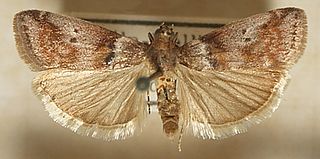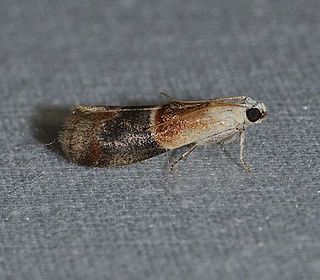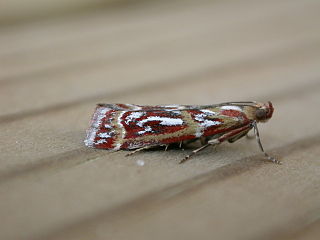
Acrobasis consociella is a moth of the family Pyralidae. It is found in Europe.

Acrobasis sodalella is a moth of the family Pyralidae. It was described by Philipp Christoph Zeller in 1848 and is found in Europe.

Acrobasis is a genus of moths of the family Pyralidae.

Acrobasis demotella, the walnut shoot moth, is a moth of the family Pyralidae described by Augustus Radcliffe Grote in 1881. It is found in North America, from Ontario south to North Carolina and west to Missouri and Michigan.

Acrobasis glaucella is a moth of the family Pyralidae described by Otto Staudinger in 1859. It is found in most of Europe.

Acrobasis porphyrella is a moth of the family Pyralidae. It is known from Spain, Portugal, France, Corsica, Sardinia, the Balearic Islands, Italy and Croatia.
Acrobasis sylviella, the ironwood tubemaker moth, is a species of snout moth in the genus Acrobasis. It was described by Charles Russell Ely in 1908 and is known from eastern Canada and the United States.
Acrobasis rubrifasciella, the alder tubemaker moth, is a species of snout moth in the genus Acrobasis. It was described by Alpheus Spring Packard in 1874, and is known from central-eastern Canada and eastern United States.
Acrobasis comptoniella, the sweetfern leaf casebearer or sweet-fern moth, is a species of snout moth in the subfamily Phycitinae. It was described by George Duryea Hulst in 1890 and is known from eastern Canada and the United States.
Acrobasis kearfottella, Kearfott's acrobasis moth, is a species of snout moth in the genus Acrobasis. It was described by Harrison Gray Dyar Jr. in 1905, and is known from Quebec, Canada, and the eastern United States.

Acrobasis palliolella, the mantled acrobasis moth, is a species of snout moth in the genus Acrobasis. It was described by Ragonot in 1887, and is known from Ontario, Canada, and the eastern United States.

Acrobasis exsulella, the cordovan pyralid moth, is a species of snout moth in the genus Acrobasis. It was described by Philipp Christoph Zeller in 1848, and is known from the southeastern United States.

Acrobasis caryae, the hickory shoot borer, is a species of snout moth in the genus Acrobasis. It was described by Augustus Radcliffe Grote in 1881, and is known from southeastern Ontario, Canada, and the eastern United States.

Acrobasis tricolorella, the destructive prune worm or tricolored acrobasis moth, is a species of snout moth in the genus Acrobasis. It was described by Augustus Radcliffe Grote in 1878, and is known from southern Canada and northern United States.

Acrobasis indigenella, the leaf crumpler, is a species of snout moth in the genus Acrobasis. It was described by Philipp Christoph Zeller in 1848, and is known from eastern North America.
Acrobasis obtusella is a species of snout moth in the genus Acrobasis. It was described by Jacob Hübner in 1796. It is found in most of Europe.
Acrobasis centunculella is a species of snout moth in the genus Acrobasis. It was described by Josef Johann Mann in 1859. It is found in southern Europe.
Acrobasis bithynella is a species of snout moth in the genus Acrobasis. It was described by Philipp Christoph Zeller in 1848, and is known from France, the Iberian Peninsula, Italy, Croatia, Crete, Turkey and Russia.

Acrobasis advenella is a species of snout moth in the genus Acrobasis. It was described by Johann Zincken in 1818 and is found in most of Europe.

Acrobasis legatea is a species of snout moth in the genus Acrobasis. It was described by Adrian Hardy Haworth in 1811. It is found in most of Europe, except the north, east to Russia and Kazakhstan.












